Options: Difference between revisions
(→Frame) |
Lady Ariel (talk | contribs) (→Frame) |
||
| Line 83: | Line 83: | ||
In [[Generation II]], there are only eight different schemes, but there are ten in {{game|FireRed and LeafGreen|s}} and twenty in {{game2|Ruby|Sapphire|Emerald}} and all of [[Generation IV]]. | In [[Generation II]], there are only eight different schemes, but there are ten in {{game|FireRed and LeafGreen|s}} and twenty in {{game2|Ruby|Sapphire|Emerald}} and all of [[Generation IV]]. | ||
=====[[Generation II]]===== | =====[[Generation II]]===== | ||
{| class="roundy" style="margin:auto; text-align:center; background: #{{ | {| class="roundy" style="margin:auto; text-align:center; background: #{{gold color}}; border: 3px solid #{{crystal color dark}}" | ||
|- | |- | ||
| [[File:Frame 1 GSC.png]] | | [[File:Frame 1 GSC.png]] | ||
| Line 90: | Line 91: | ||
| [[File:Frame 3 GSC.png]] | | [[File:Frame 3 GSC.png]] | ||
| [[File:Frame 4 GSC.png]] | | [[File:Frame 4 GSC.png]] | ||
|- style="background: # | |- | ||
| Frame 1 | | style="background: #{{silver color light}}; {{roundybottom|5px}}" | Frame 1 | ||
| Frame 2 | | style="background: #{{silver color light}}; {{roundybottom|5px}}" | Frame 2 | ||
| Frame 3 | | style="background: #{{silver color light}}; {{roundybottom|5px}}" | Frame 3 | ||
| Frame 4 | | style="background: #{{silver color light}}; {{roundybottom|5px}}" | Frame 4 | ||
|- | |- | ||
| [[File:Frame 5 GSC.png]] | | [[File:Frame 5 GSC.png]] | ||
| Line 100: | Line 101: | ||
| [[File:Frame 7 GSC.png]] | | [[File:Frame 7 GSC.png]] | ||
| [[File:Frame 8 GSC.png]] | | [[File:Frame 8 GSC.png]] | ||
|- style="background: # | |- | ||
| Frame 5 | | style="background: #{{silver color light}}; {{roundybottom|5px}}" | Frame 5 | ||
| Frame 6 | | style="background: #{{silver color light}}; {{roundybottom|5px}}" | Frame 6 | ||
| Frame 7 | | style="background: #{{silver color light}}; {{roundybottom|5px}}" | Frame 7 | ||
| Frame 8 | | style="background: #{{silver color light}}; {{roundybottom|5px}}" | Frame 8 | ||
|} | |} | ||
=====[[Generation III]]===== | =====[[Generation III]]===== | ||
======{{game2|Ruby|Sapphire|Emerald}}====== | ======{{game2|Ruby|Sapphire|Emerald}}====== | ||
{| class="roundy" style="margin:auto; text-align:center; background: #{{ | {| class="roundy" style="margin:auto; text-align:center; background: #{{ruby color}}; border: 3px solid #{{emerald color dark}}" | ||
|- | |- | ||
| [[File:Frame 1 RSE.png]] | | [[File:Frame 1 RSE.png]] | ||
| Line 114: | Line 116: | ||
| [[File:Frame 3 RSE.png]] | | [[File:Frame 3 RSE.png]] | ||
| [[File:Frame 4 RSE.png]] | | [[File:Frame 4 RSE.png]] | ||
|- style="background: # | |- | ||
| Frame 1 | | style="background: #{{sapphire color light}}; {{roundybottom|5px}}" | Frame 1 | ||
| Frame 2 | | style="background: #{{sapphire color light}}; {{roundybottom|5px}}" | Frame 2 | ||
| Frame 3 | | style="background: #{{sapphire color light}}; {{roundybottom|5px}}" | Frame 3 | ||
| Frame 4 | | style="background: #{{sapphire color light}}; {{roundybottom|5px}}" | Frame 4 | ||
|- | |- | ||
| [[File:Frame 5 RSE.png]] | | [[File:Frame 5 RSE.png]] | ||
| Line 124: | Line 126: | ||
| [[File:Frame 7 RSE.png]] | | [[File:Frame 7 RSE.png]] | ||
| [[File:Frame 8 RSE.png]] | | [[File:Frame 8 RSE.png]] | ||
|- style="background: # | |- | ||
| Frame 5 | | style="background: #{{sapphire color light}}; {{roundybottom|5px}}" | Frame 5 | ||
| Frame 6 | | style="background: #{{sapphire color light}}; {{roundybottom|5px}}" | Frame 6 | ||
| Frame 7 | | style="background: #{{sapphire color light}}; {{roundybottom|5px}}" | Frame 7 | ||
| Frame 8 | | style="background: #{{sapphire color light}}; {{roundybottom|5px}}" | Frame 8 | ||
|- | |- | ||
| [[File:Frame 9 RSE.png]] | | [[File:Frame 9 RSE.png]] | ||
| Line 134: | Line 136: | ||
| [[File:Frame 11 RSE.png]] | | [[File:Frame 11 RSE.png]] | ||
| [[File:Frame 12 RSE.png]] | | [[File:Frame 12 RSE.png]] | ||
|- style="background: # | |- | ||
| Frame 9 | | style="background: #{{sapphire color light}}; {{roundybottom|5px}}" | Frame 9 | ||
| Frame 10 | | style="background: #{{sapphire color light}}; {{roundybottom|5px}}" | Frame 10 | ||
| Frame 11 | | style="background: #{{sapphire color light}}; {{roundybottom|5px}}" | Frame 11 | ||
| Frame 12 | | style="background: #{{sapphire color light}}; {{roundybottom|5px}}" | Frame 12 | ||
|- | |- | ||
| [[File:Frame 13 RSE.png]] | | [[File:Frame 13 RSE.png]] | ||
| Line 144: | Line 146: | ||
| [[File:Frame 15 RSE.png]] | | [[File:Frame 15 RSE.png]] | ||
| [[File:Frame 16 RSE.png]] | | [[File:Frame 16 RSE.png]] | ||
|- style="background: # | |- | ||
| Frame 13 | | style="background: #{{sapphire color light}}; {{roundybottom|5px}}" | Frame 13 | ||
| Frame 14 | | style="background: #{{sapphire color light}}; {{roundybottom|5px}}" | Frame 14 | ||
| Frame 15 | | style="background: #{{sapphire color light}}; {{roundybottom|5px}}" | Frame 15 | ||
| Frame 16 | | style="background: #{{sapphire color light}}; {{roundybottom|5px}}" | Frame 16 | ||
|- | |- | ||
| [[File:Frame 17 RSE.png]] | | [[File:Frame 17 RSE.png]] | ||
| Line 154: | Line 156: | ||
| [[File:Frame 19 RSE.png]] | | [[File:Frame 19 RSE.png]] | ||
| [[File:Frame 20 RSE.png]] | | [[File:Frame 20 RSE.png]] | ||
|- style="background: # | |- | ||
| Frame 17 | | style="background: #{{sapphire color light}}; {{roundybottom|5px}}" | Frame 17 | ||
| Frame 18 | | style="background: #{{sapphire color light}}; {{roundybottom|5px}}" | Frame 18 | ||
| Frame 19 | | style="background: #{{sapphire color light}}; {{roundybottom|5px}}" | Frame 19 | ||
| Frame 20 | | style="background: #{{sapphire color light}}; {{roundybottom|5px}}" | Frame 20 | ||
|} | |} | ||
======{{game|FireRed and LeafGreen|s}}====== | ======{{game|FireRed and LeafGreen|s}}====== | ||
{| class="roundy" style="margin:auto; text-align:center; background: #{{ | {| class="roundy" style="margin:auto; text-align:center; background: #{{firered color}}; border: 3px solid #{{firered color dark}}" | ||
|- | |- | ||
| [[File:Frame 1 FRLG.png]] | | [[File:Frame 1 FRLG.png]] | ||
| Line 167: | Line 170: | ||
| [[File:Frame 3 FRLG.png]] | | [[File:Frame 3 FRLG.png]] | ||
| [[File:Frame 4 FRLG.png]] | | [[File:Frame 4 FRLG.png]] | ||
|- style="background: # | |- | ||
| Frame 1 | | style="background: #{{leafgreen color light}}; {{roundybottom|5px}}" | Frame 1 | ||
| Frame 2 | | style="background: #{{leafgreen color light}}; {{roundybottom|5px}}" | Frame 2 | ||
| Frame 3 | | style="background: #{{leafgreen color light}}; {{roundybottom|5px}}" | Frame 3 | ||
| Frame 4 | | style="background: #{{leafgreen color light}}; {{roundybottom|5px}}" | Frame 4 | ||
|- | |- | ||
| [[File:Frame 5 FRLG.png]] | | [[File:Frame 5 FRLG.png]] | ||
| Line 178: | Line 181: | ||
| [[File:Frame 8 FRLG.png]] | | [[File:Frame 8 FRLG.png]] | ||
|- style="background: #FFFFFF" | |- style="background: #FFFFFF" | ||
| Frame 5 | | style="background: #{{leafgreen color light}}; {{roundybottom|5px}}" | Frame 5 | ||
| Frame 6 | | style="background: #{{leafgreen color light}}; {{roundybottom|5px}}" | Frame 6 | ||
| Frame 7 | | style="background: #{{leafgreen color light}}; {{roundybottom|5px}}" | Frame 7 | ||
| Frame 8 | | style="background: #{{leafgreen color light}}; {{roundybottom|5px}}" | Frame 8 | ||
|- | |- | ||
| | | | ||
| Line 189: | Line 192: | ||
|- | |- | ||
| | | | ||
|style="background: # | | style="background: #{{leafgreen color light}}; {{roundybottom|5px}}" | Frame 9 | ||
|style="background: # | | style="background: #{{leafgreen color light}}; {{roundybottom|5px}}" | Frame 10 | ||
| | | | ||
|} | |} | ||
Revision as of 20:51, 8 March 2015

|
The picture used in this intro section is unsatisfactory. Please feel free to replace it so it conforms to Bulbapedia conventions. Reason: Needs picture from Generation VI |
The Options (Japanese: 設定 options) menu in the core series Pokémon games provides the management of settings that the player can modify to change aspects of the game. The available settings differ throughout the various games.
It can be accessed by selecting the corresponding entry on the menu. From Pokémon Red and Green to Pokémon Emerald, it can also be accessed from the title screen, but it is not possible to do this in Pokémon FireRed and LeafGreen and in any game from Pokémon Diamond and Pearl onwards.
List of options
In every game
Text Speed
This setting controls the speed of the text in the text box. It is called 話の速さ text speed in Japanese.
- Slow (Japanese: 遅い slow)
- Normal (Japanese: 普通 normal), known as Medium or MID prior to Generation VI
- Fast (Japanese: 速い fast)
The default speed is Normal.
In Generation I, the text speed could be set to a hidden fourth option by using cheats or glitches, disabling the delay entirely.
Battle Effects
- Main article: Battle effects
This setting controls the appearance of graphical effects during battles.
The default state is On.
Prior to Generation VI, it was called Battle Scene or Battle AnimationRB/AnimationY in English. In Japanese, it's called 戦闘アニメ or せんとうアニメーションRGB, meaning "battle animations". In the Japanese Ruby, Sapphire, and Emerald, it's called せんとうエフェクト battle effects.
In Generation I, the battle effects are displayed during the Champion battle against the rival even if this feature is turned off.
Battle Style
This setting controls the switching of Pokémon in-between one Trainer's Pokémon fainting. It is called 試合のルール game rules in Japanese.
- Switch (Japanese: いれかえ switch, いれかえタイプRGBYGSC switching type), which allows the player to call a different Pokémon when the opposing Pokémon faints; known as Shift prior to Generation VI
- Set (Japanese: かちぬき knockout, かちぬきタイプRGBYGSC knockout type), which will have the next Pokémon immediately sent out
The default choice is Switch but in a Double or Triple Battle, the battle style will always be Set.
In Generation IV, if the choice is Set and the player's Pokémon is knocked out against a wild Pokémon, the player will be forced to send out his or her next Pokémon without being given the option to immediately escape.
In specific games
Sound
This is an option that appears from Pokémon Yellow to Pokémon Black 2 and White 2, and is called サウンド sound in Japanese. It controls how audio is played through the speakers of the handheld. It was removed starting in Pokémon X and Y due to the games now using the handheld's system settings.
- Mono (Japanese: モノラル monaural)
- Stereo (Japanese: ステレオ stereo)
In Pokémon Yellow, instead of Stereo, the player can choose:
- Earphone 1 (Japanese: イヤホン1 earphone 1), the equivalent to Stereo in later games
- Earphone 2 (Japanese: イヤホン2 earphone 2), which focuses the audio to the left earphone
- Earphone 3 (Japanese: イヤホン3 earphone 3), which focuses the audio to the right earphone
The default choice from Pokémon Yellow to Pokémon Emerald is Mono, having been changed to Stereo from Pokémon Diamond and Pearl onwards.
This is an option that only appears in Pokémon Yellow, Gold, Silver, and Crystal. This setting controls the contrast of prints through the Game Boy Printer. It is called プリントのこさ print density in Japanese. It is absent from the Korean versions of Gold and Silver.
- Normal (Japanese: ふつう normal)
- Darker (Japanese: ややこい darker)
- Darkest (Japanese: こい dark)
- Lightest (Japanese: うすい light)
- Lighter (Japanese: ややうすい lighter)
The default choice is Normal.
Menu Account
This is an option that appears exclusively in Pokémon Gold, Silver, and Crystal. This setting controls whether or not descriptions appear for the menu functions. It is called メニューせつめい menu explanation in Japanese.
- On (Japanese: ひょうじする display)
- Off (Japanese: ひょうじしない do not display)
The default state is On.
Frame

|
This section is incomplete. Please feel free to edit this section to add missing information and complete it. Reason: Screenshots from Generation IV games |
This is an option that appears from Pokémon Gold and Silver to Pokémon HeartGold and SoulSilver. This setting controls the appearance of the border around text boxes. It is called ウインドウ window in Japanese.
The default frame in every game is Type 1 (Japanese: タイプ1 type 1).
In Generation II, there are only eight different schemes, but there are ten in Pokémon FireRed and LeafGreen and twenty in Pokémon Ruby, Sapphire, and Emerald and all of Generation IV.
Generation II
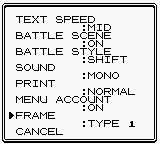
|
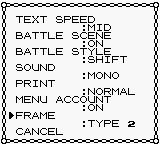
|
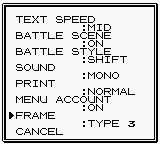
|
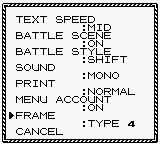
|
| Frame 1 | Frame 2 | Frame 3 | Frame 4 |
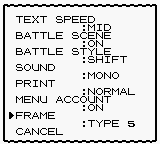
|
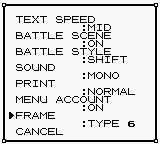
|
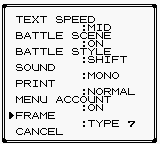
|
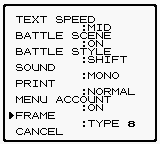
|
| Frame 5 | Frame 6 | Frame 7 | Frame 8 |
Generation III
Pokémon Ruby, Sapphire, and Emerald
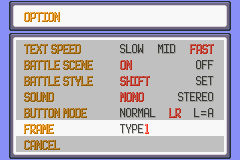
|
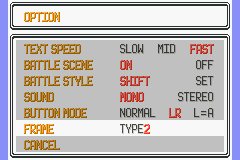
|
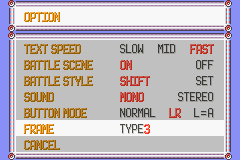
|
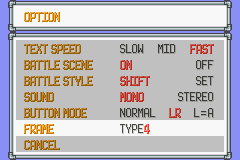
|
| Frame 1 | Frame 2 | Frame 3 | Frame 4 |
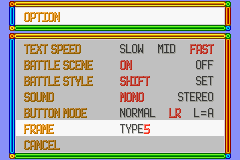
|
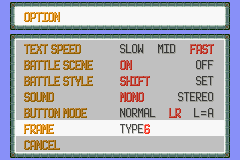
|
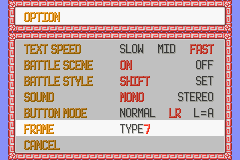
|
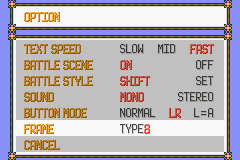
|
| Frame 5 | Frame 6 | Frame 7 | Frame 8 |
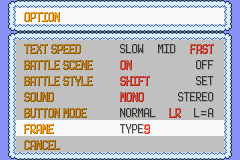
|
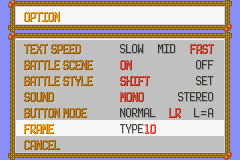
|
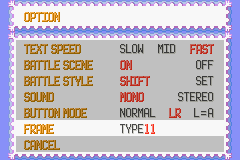
|
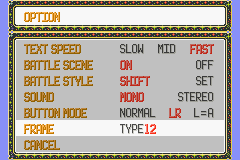
|
| Frame 9 | Frame 10 | Frame 11 | Frame 12 |
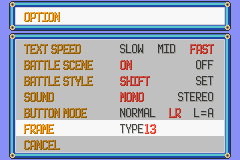
|
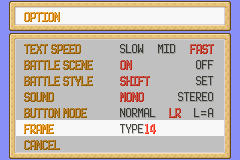
|
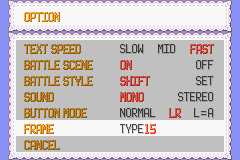
|
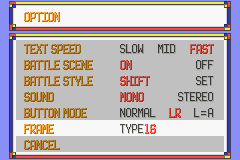
|
| Frame 13 | Frame 14 | Frame 15 | Frame 16 |
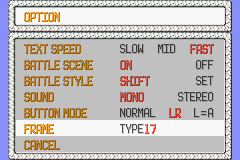
|
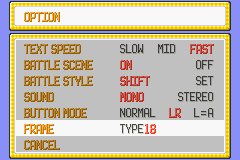
|
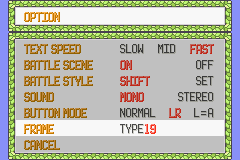
|
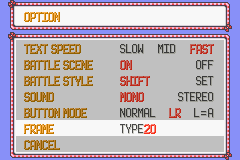
|
| Frame 17 | Frame 18 | Frame 19 | Frame 20 |
Pokémon FireRed and LeafGreen
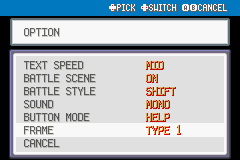
|
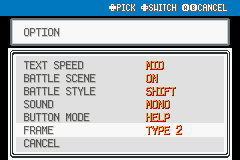
|
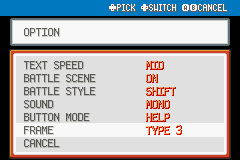
|
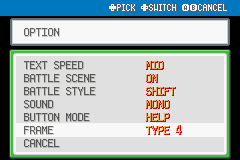
|
| Frame 1 | Frame 2 | Frame 3 | Frame 4 |
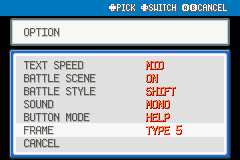
|
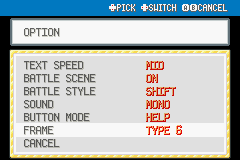
|
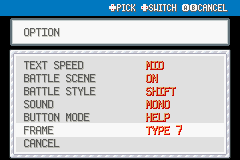
|
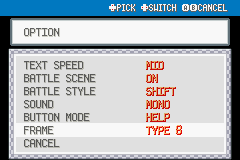
|
| Frame 5 | Frame 6 | Frame 7 | Frame 8 |
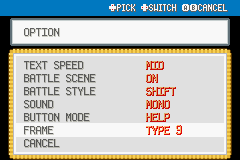
|
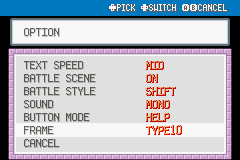
|
||
| Frame 9 | Frame 10 |
Button Mode
This is an option that appears since Generation III, although it is notably absent from Generation V. This setting controls the handheld's button configuration for the game. It is called ボタンモード or ボタンのモードRSE in Japanese, meaning "button mode".
The default mode in every game is Default.
- Generation III
In Pokémon Ruby, Sapphire, and Emerald, there are three available modes: Normal (Japanese: ノーマル normal), LR (Japanese: LR), and L=A (Japanese: L=A). Normal restricts the player to only the A and B buttons, while LR allows using the L and R buttons to switch between certain menus, such as Bag pockets or Pokémon Storage System boxes. The L=A option remaps the A button to the L button.
In Pokémon FireRed and LeafGreen, Normal is renamed to Help (Japanese: ヘルプ help), since pressing the L or R buttons opens the help menu, which contains essential tips about the game for the player. In the Japanese versions, L=A is also renamed to かたて single-handed.
- Generation IV
In Pokémon Diamond, Pearl, and Platinum, Help is renamed back to Normal and, in the Japanese versions, かたて is renamed back to L=A. LR is replaced with START=X (Japanese: START=X), wherein the player can use the START button instead of the X button to open the menu. This choice is removed in Pokémon HeartGold and SoulSilver, leaving just Normal and L=A as available choices.
Unlike in the Generation III and VI games, there is no equivalent to LR, whether as an option or as an embedded function.
- Generation VI
In the Generation VI games, Normal is renamed Default in the English versions, with the L and R buttons being used to switch between the Player Search System, Pokémon-Amie, and Super Training menus; L=A also returns and a new third option called No L/R Button (Japanese: LRきんし No LR) is added, which disables the L and R buttons entirely.
Confirm/Close
Only in Pokémon Diamond, Pearl, and Platinum, a ConfirmDP (Japanese: けっていDP confirm) or ClosePt (Japanese: とじるPt close) option was added to save the Options menu's settings. Pressing the B button does not save them, though in Pokémon Platinum, the player is prompted to confirm any adjustments made to the settings.
Character mode
Exclusively in the Japanese versions starting in Pokémon Black and White, a new option called character mode (Japanese: 文字モード) is available. This setting controls whether the game displays only kana or also kanji. The two available choices are, in kana-only mode: ひらがな (hiragana) and かんじ (kanji); in kanji mode, they are: ひらがな (hiragana) and 漢字 (kanji). The default choice is ひらがな.
It is also the first thing to be set right after starting a new game on the title screen menu, although it can still be configured later in the Options menu. Here, the player also has two choices: かな (kana) and 漢字 (kanji).
Save before IR
This is an option exclusive to the Generation V games. This setting controls whether the game is saved or not before C-Gear enables infrared connectivity. It is called IRのレポート save before IR in Japanese.
- Save (Japanese: 書く write)
- Don't Save (Japanese: 書かない don't write)
The default setting is Save.
Battle BG

|
This section is incomplete. Please feel free to edit this section to add missing information and complete it. Reason: Screenshots |
This is an option exclusive to Pokémon X and Y. This setting controls the appearance of the background behind the choices on the touch screen during battles, a graphical element first introduced in Generation IV. It is called 戦闘壁紙 battle background in Japanese.
There are fifteen different backgrounds for the player to choose from:
- Default (Japanese: デフォルト default)
- Red (Japanese: レッド red)
- Blue (Japanese: ブルー blue)
- Pikachu (Japanese: ピカチュウ Pikachu)
- Starters (Japanese: はじめての3たい the very first three)
- Eevee (Japanese: イーブイ Eievui)
- Monochrome (Japanese: モノトーン monotone)
- Stickers (Japanese: ポケモンシール Pokémon Seals)
- Tatami (Japanese: わふう Japanese style)
- Floral Print (Japanese: はながら floral pattern)
- Elegant (Japanese: エレガント elegant)
- Tall Grass (Japanese: くさむら tall grass)
- Polka Balls (Japanese: ドット polka dots)
- Cockpit (Japanese: コックピット cockpit)
- Carbon (Japanese: カーボン carbon)
The default background is Default.
Forced Save
This is an option exclusive to Generation VI. This setting controls whether the game is saved or not before Player Search System battles and "other communication features". It is called 通信レポート save before link in Japanese.
- Save (Japanese: 書く write)
- Don't Save (Japanese: 書かない don't write)
The default setting is Save.
| |||||||

|
This game mechanic article is part of Project Games, a Bulbapedia project that aims to write comprehensive articles on the Pokémon games. |